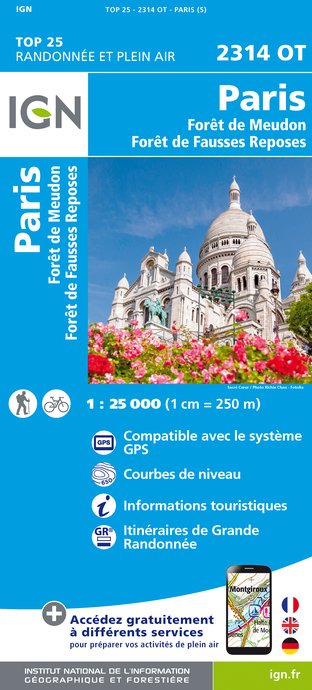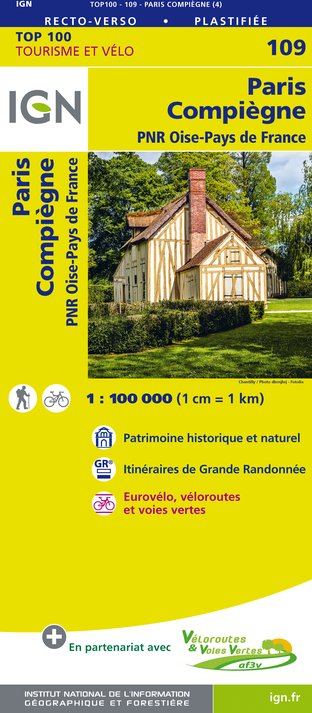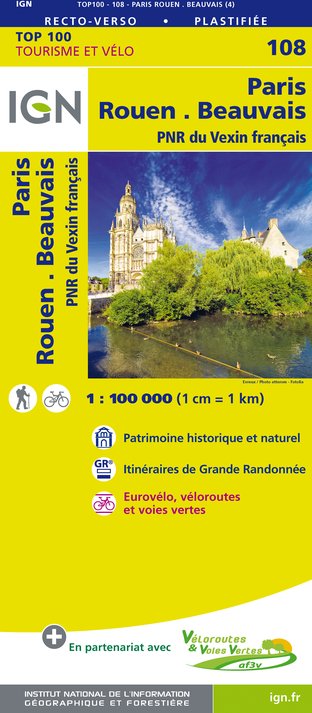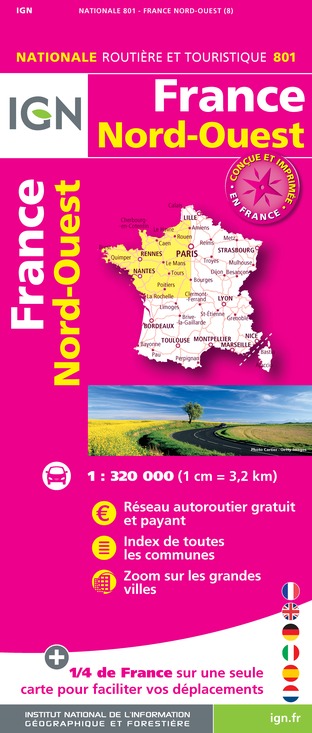Allarme
Allarmi
Tipo di pratica
In barca
A piedi
Molto facile
In bicicletta
In auto
Presentazione
Mappa
Tappe
Punti di interesse
Sintesi di Cirkwi
Valutazioni e recensioni
Vedi nei dintorni
Le statue dei ponti di Parigi

Credito : Remi Jouan
Il breve di Cirkwi
Scopri le statue storiche dei ponti di Parigi: un viaggio unico
I ponti parigini, arricchiti da statue che raccontano storie del passato della città, creano un'esperienza di passeggiata senza pari. Proposto da Balades Fluviales Fabienne Lemoine Fondateur, questo itinerario non è solo una passeggiata, ma un viaggio nel tempo, rivelando i tesori artistici e culturali di Parigi da quando la costruzione dei ponti era tanto una questione di bellezza quanto di utilità. Intraprendendo questo percorso panoramico, ci si imbarca in una scoperta che collega l'anima della città attraverso i suoi guardiani monumentali. Senti la brezza della Senna e lascia che le silenziose figure guidino la tua scoperta.
Panoramica tecnica del percorso
Coprendo una distanza totale di 8,08 chilometri con una variazione di altitudine tra 27 e 38 metri, questo percorso offre una miscela interessante di salite e discese lievi, per un'elevazione positiva totale di 125 metri. Progettato per il camminare, questo circuito offre un viaggio coinvolgente ma fisicamente moderato attraverso Parigi, adatto a partecipanti con diversi livelli di fitness. Mettendo in risalto le statue sui ponti parigini, il percorso proposto da Balades Fluviales guida gli esploratori attraverso meraviglie storiche e architettoniche, presentando un aspetto affascinante dell'ornamentazione urbana.
Suggerimenti stagionali per gli esploratori delle statue dei ponti
Esplorare i ponti statuari di Parigi è incantevole in qualsiasi periodo dell'anno, ma ogni stagione ha le sue sfumature. In primavera, i fiori in fiore aggiungono uno sfondo pittoresco, ma occorre anche aspettarsi occasionali piogge; porta sempre con te un ombrello. Le estati sono ideali ma possono diventare affollate; le passeggiate mattutine sono preferibili. L'autunno dona un tono dorato al paesaggio, perfetto per la fotografia, anche se la luce serale svanisce rapidamente; pianifica di conseguenza. L'inverno, sebbene freddo, offre un'esperienza serena con minor afflusso di persone; vestirsi caldamente è fondamentale. Per quanto riguarda la sicurezza, rimani sempre sulle piste pedonali e presta attenzione alle superfici scivolose in condizioni di umidità.
Il cuore culturale della Francia
Parigi, situata nella regione dell'Île-de-France, è non solo la capitale della Francia, ma anche un faro di importanza culturale e storica a livello mondiale. I ponti della città, che incarnano meraviglie artistiche e ingegneristiche dal XIX secolo, fungono da connettori vitali non solo tra le rive del fiume, ma anche attraverso il tempo. Ogni statua racconta una parte del passato leggendario di Parigi, dalle storie dei santi patroni agli eventi monumentali. Esplorare questi ponti consente di attraversare il cuore della città, comprendendone l'evoluzione e il fascino duraturo.
Informazioni sul clima per i visitatori di Parigi
Parigi: ti aspetta un clima continentale mite. Parigi ha un clima temperato, caratterizzato da estati miti e inverni freschi. I mesi ideali per la visita vanno da aprile a giugno e da settembre a ottobre, quando le condizioni meteorologiche sono più favorevoli per esplorare all'aperto. In questi periodi, aspettati temperature medie comprese tra i 15°C e i 25°C, creando un'atmosfera confortevole per i tour delle statue dei ponti. Le estati possono raggiungere fino a 30°C, influenzando potenzialmente le attività all'aperto durante le ore diurne. Gli inverni, anche se più freddi, raramente registrano flessioni drastiche al di sotto di 0°C, ma è consigliato prepararsi per condizioni variabili.
I ponti parigini, arricchiti da statue che raccontano storie del passato della città, creano un'esperienza di passeggiata senza pari. Proposto da Balades Fluviales Fabienne Lemoine Fondateur, questo itinerario non è solo una passeggiata, ma un viaggio nel tempo, rivelando i tesori artistici e culturali di Parigi da quando la costruzione dei ponti era tanto una questione di bellezza quanto di utilità. Intraprendendo questo percorso panoramico, ci si imbarca in una scoperta che collega l'anima della città attraverso i suoi guardiani monumentali. Senti la brezza della Senna e lascia che le silenziose figure guidino la tua scoperta.
Panoramica tecnica del percorso
Coprendo una distanza totale di 8,08 chilometri con una variazione di altitudine tra 27 e 38 metri, questo percorso offre una miscela interessante di salite e discese lievi, per un'elevazione positiva totale di 125 metri. Progettato per il camminare, questo circuito offre un viaggio coinvolgente ma fisicamente moderato attraverso Parigi, adatto a partecipanti con diversi livelli di fitness. Mettendo in risalto le statue sui ponti parigini, il percorso proposto da Balades Fluviales guida gli esploratori attraverso meraviglie storiche e architettoniche, presentando un aspetto affascinante dell'ornamentazione urbana.
Suggerimenti stagionali per gli esploratori delle statue dei ponti
Esplorare i ponti statuari di Parigi è incantevole in qualsiasi periodo dell'anno, ma ogni stagione ha le sue sfumature. In primavera, i fiori in fiore aggiungono uno sfondo pittoresco, ma occorre anche aspettarsi occasionali piogge; porta sempre con te un ombrello. Le estati sono ideali ma possono diventare affollate; le passeggiate mattutine sono preferibili. L'autunno dona un tono dorato al paesaggio, perfetto per la fotografia, anche se la luce serale svanisce rapidamente; pianifica di conseguenza. L'inverno, sebbene freddo, offre un'esperienza serena con minor afflusso di persone; vestirsi caldamente è fondamentale. Per quanto riguarda la sicurezza, rimani sempre sulle piste pedonali e presta attenzione alle superfici scivolose in condizioni di umidità.
Il cuore culturale della Francia
Parigi, situata nella regione dell'Île-de-France, è non solo la capitale della Francia, ma anche un faro di importanza culturale e storica a livello mondiale. I ponti della città, che incarnano meraviglie artistiche e ingegneristiche dal XIX secolo, fungono da connettori vitali non solo tra le rive del fiume, ma anche attraverso il tempo. Ogni statua racconta una parte del passato leggendario di Parigi, dalle storie dei santi patroni agli eventi monumentali. Esplorare questi ponti consente di attraversare il cuore della città, comprendendone l'evoluzione e il fascino duraturo.
Informazioni sul clima per i visitatori di Parigi
Parigi: ti aspetta un clima continentale mite. Parigi ha un clima temperato, caratterizzato da estati miti e inverni freschi. I mesi ideali per la visita vanno da aprile a giugno e da settembre a ottobre, quando le condizioni meteorologiche sono più favorevoli per esplorare all'aperto. In questi periodi, aspettati temperature medie comprese tra i 15°C e i 25°C, creando un'atmosfera confortevole per i tour delle statue dei ponti. Le estati possono raggiungere fino a 30°C, influenzando potenzialmente le attività all'aperto durante le ore diurne. Gli inverni, anche se più freddi, raramente registrano flessioni drastiche al di sotto di 0°C, ma è consigliato prepararsi per condizioni variabili.
Generato automaticamente.
IGN Carte

2314OT - PARIS FORÊT DE MEUDON FORÊT DE FAUSSES REPOSES
Editore : IGN
Collezione : TOP 25 ET SÉRIE BLEUE
Scala : 1:25 000
13.90€

119 PARIS SENS PNR DU GÂTINAIS FRANÇAIS
Editore : IGN
Collezione : TOP 100
Scala : 1:100 000
8.40€

190 PARIS CHANTILLY FONTAINEBLEAU
Editore : IGN
Collezione : TOP 100
Scala : 1:100 000
8.40€

118 PARIS CHARTRES PNR DE LA HAUTE VALLÉE DE CHEVREUSE
Editore : IGN
Collezione : TOP 100
Scala : 1:100 000
8.40€

109 PARIS COMPIÈGNE PNR OISE-PAYS DE FRANCE
Editore : IGN
Collezione : TOP 100
Scala : 1:100 000
8.40€

108 PARIS ROUEN BEAUVAIS PNR DU VEXIN FRANÇAIS
Editore : IGN
Collezione : TOP 100
Scala : 1:100 000
8.40€

D75-95 ÎLE-DE-FRANCE OUEST
Editore : IGN
Collezione : CARTES DÉPARTEMENTALES IGN
Scala : 1:150 000
5.90€

D77 SEINE-ET-MARNE
Editore : IGN
Collezione : CARTES DÉPARTEMENTALES IGN
Scala : 1:150 000
5.90€

NR08 CENTRE-VAL DE LOIRE
Editore : IGN
Collezione : CARTES RÉGIONALES IGN
Scala : 1:250 000
6.80€

NR03 ÍLE DE FRANCE
Editore : IGN
Collezione : CARTES RÉGIONALES IGN
Scala : 1:250 000
6.80€

NR01 HAUTS-DE-FRANCE
Editore : IGN
Collezione : CARTES RÉGIONALES IGN
Scala : 1:250 000
6.80€

801 FRANCE NORD OUEST
Editore : IGN
Collezione : CARTES NATIONALES IGN
Scala : 1:320 000
6.10€

EUROPE
Editore : IGN
Collezione : DÉCOUVERTE DES PAYS DU MONDE IGN
Scala : 1:2 500 000
7.00€
Informazioni tecniche
In barca
Difficoltà
Non specificata
Dist.
8.1 km
Tipo di pratica
In barca
A piedi
Molto facile
In bicicletta
In auto
Mostra di più
Profilo altimetrico
Punto di partenza
75004
Paris
Lat : 48.8506677Lng : 2.3555267
Punti di interesse
Autore dei dati
Valutazioni e recensioni
Da vedere nei dintorni










